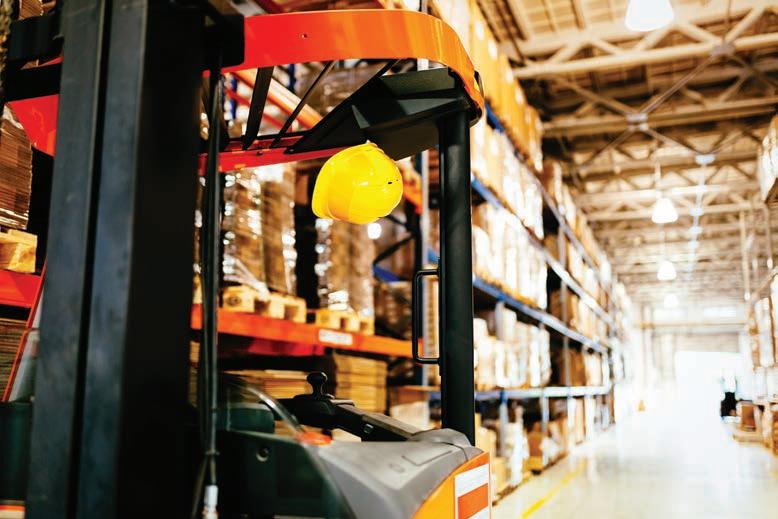
4 minute read
LOGISTICS
REALISING LOGISTICS 4.0
Are South African logistics companies adopting digital? JAMES FRANCIS finds out
The story of the shipping container is a microcosm of logistical evolution. In 1955, Malcom McLean sold the third-largest transportation business in the US and bought a steamship company with access to a port. He then created the first modern shipping container, designed to fit snugly on a specific type of truck. Stackable, he could fit 58 such containers on an oil tanker he acquired. This jump in efficiency enabled McLean to charge prices a quarter cheaper than his competitors.
A decade later, shipping containers would become standardised, leading to enormous efficiencies across the entire logistics industry.
THE FUTURE OF LOGISTICS?
Supporters of Logistics 4.0 (L4.0) – applying fourth industrial revolution (4IR) technologies to the logistics sector – are hoping for a similar jump. But as with many digital ambitions, it’s tough to move from plans to reality.
“The logistics industry varies substantially – typically making up close to 20 per cent of the gross domestic product,” says Martin Bailey FCILT, vice president of the Chartered Institute of Logistics and Transport.
“Some components have moved into the 4IR, but much of the industry and related processes are relatively unsophisticated.”
According to flexis, a supply chain solution provider, L4.0 typically encounters three barriers: reducing shadow IT (unapproved software) and information silos; breaking free from past-oriented planning; and ditching the spreadsheet. This last point is perhaps

CHARTERED INSTITUTE OF LOGISTICS AND TRANSPORT
the most crucial, as it is symbolic of cultural resistance against the changes digital brings.
“The integration of silos across businesses is still the most challenging part of optimising logistic operations for many businesses,” Bailey explains. “Changing this usually involves changing the entire culture of organisations – a difficult task.”
TRANSFORMATION IN ACTION
That is not an understatement. Only 22 per cent of digital transformation projects deliver business value, according to a 2018 survey from the Everest Group. But the pandemic has been catalytic, says Archie Vermeulen, managing director at RAM Supply Chain Service (SCS). “This pandemic just changed the whole ballgame because agility is where it’s at. Now, you’ve got to move quickly.
“We’ve witnessed many incredible advances through the likes of Amazon, Walmart and Apple, essentially logistics companies that amplify different products through their value chains. But over time, their processes and systems have standardised, reducing agility. Thus, right now is a great time for other logistics companies to digitise.”
In RAM’s case, the company embraced an ambitious vision to modernise its warehouse operations. RAM SCS is effectively a separate business, offering advanced warehousing to RAM couriers as well as other customers. Starting with a high-tech site in Isando, Johannesburg, RAM SCS leads a massive digital modernisation wave of warehousing in South Africa.
To a degree, this new arm could start with a fresh culture and approach, which Vermeulen divides into three priorities: dock levellers, for more streamlined on- and off-loading, providing services to a variety of customers (not just RAM couriers), and using a best-of-breed warehouse management system (WMS).
This approach enables the three tiers of digitisation: process, people and technology. Notably, the bric-à-brac of L4.0 – internet of things gadgets, radio frequency identification tags, barcodes, data flow – could all emerge through the integrated WMS, which also enables concepts such as reverse logistics.
“Reverse logistics is essentially the ability to return goods, and it’s growing more important, especially because of e-commerce,” Vermeulen explains. But reverse logistics is a different animal to delivering goods, requiring closer support for finance and credit management. This is why a digitised warehouse backed by a modern WMS is crucial. The concept reveals how warehousing, and logistics in general, has to evolve and not just adapt.
“It’s an infinite journey and there’s no end – we’ve started, we get better,” says Vermeulen. “We believe this journey will make us a serious competitor among the strong contenders out there. The guys that we compete against are no slouches. They’ve been at it for a long time, they know what’s going on. That’s great because they make everybody up their game. Everyone is trying harder. And I like it.”
ARCHIE VERMEULEN, RAM SUPPLY CHAIN SERVICE FAST FACT
New business models, such as Supply Chain as a Service increase the flexibility in the supply chain organisation. Rather than maintaining resources and capabilities in-house, companies can buy individual supply-chain functions as a service on a by-usage basis. Source: McKinsey




